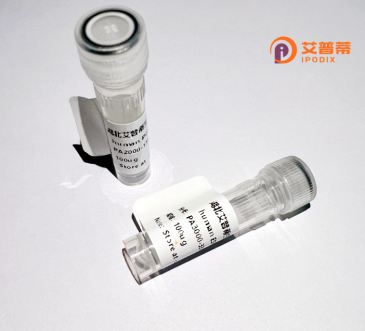
| 纯度 | >90%SDS-PAGE. |
| 种属 | Human |
| 靶点 | ZNF786 |
| Uniprot No | Q8N393 |
| 内毒素 | < 0.01EU/μg |
| 表达宿主 | E.coli |
| 表达区间 | 1-782 aa |
| 活性数据 | MAEPPRLPLTFEDVAIYFSEQEWQDLEAWQKELYKHVMRSNYETLVSLDDGLPKPELISWIEHGGEPFRKWRESQKSGNIICSSVDMHFDPGFEEQLFWGSQQAMNSGKTKSHFQLDPESQCSFGSFVSFRPDQGITLGSPQRHDARAPPPLACGPSESTLKEGIPGPRNLDLPGLWDVPAWESTQHPWPVCGESCWENNHLVMHQRGHSKDRTRRAWEKFNKRAETQMPWSSPRVQRHFRCGVCGKSFRRKLCLLRHLAAHTGRGPFRNADGEMCFRHELTHPSHRLPQQGEKPAQCTPCGKRSLPVDSTQARRCQHSREGPASWREGRGASSSVHSGQKPGSRLPQEGNSHQEGDTEALQHGAEGPCSCSECGERSPMSARLASPCRAHTGEKPFQCAHCTKRFRLRRLLQVHQHAHGGERPFSCRKCGKGFAKQCKLTEHIRVHSGEKPFRCAKCGRNFRQRGQLLRHQRLHTDEKPFQCPECGLSFRLESMLRAHRLRHGGERPFSCSECGRGFTHQCKLREHLRVHSGERPFQCLKCDKRFRLKGILKAHQHTHSKERPFSCGECGKGFTRQSKLTEHLRVHSGERPFQCPECNRSFRLKGQLLSHQRLHTGERPFQCPECDKRYRVKADMKAHQLLHSGEMPFSCECGKGFVKHSKLIEHIRTHTGEKPFQCPKCDKSFRLKAQLLSHQGLHTGERPFHCPECDKNFWERGHMLRHQRIHRPERPFACGDCGKGFIYKSKLAEHIRVHTKSCPAPNELDIKKRLSQLFAMIEADWS |
| 分子量 | 112.42 kDa |
| 蛋白标签 | GST-tag at N-terminal |
| 缓冲液 | PBS, pH7.4, containing 0.01% SKL, 1mM DTT, 5% Trehalose and Proclin300. |
| 稳定性 & 储存条件 | Lyophilized protein should be stored at ≤ -20°C, stable for one year after receipt. Reconstituted protein solution can be stored at 2-8°C for 2-7 days. Aliquots of reconstituted samples are stable at ≤ -20°C for 3 months. |
| 复溶 | Always centrifuge tubes before opening.Do not mix by vortex or pipetting. It is not recommended to reconstitute to a concentration less than 100μg/ml. Dissolve the lyophilized protein in distilled water. Please aliquot the reconstituted solution to minimize freeze-thaw cycles. |
以下是3-4篇关于人ZNF786蛋白的虚拟参考文献示例(基于类似领域研究模式概括):
1. **文献名称**:*Functional Characterization of Human ZNF786 as a Novel Transcriptional Repressor*
**作者**:Chen L, et al.
**摘要**:研究首次克隆并表达了重组人ZNF786蛋白,发现其通过结合特定DNA序列抑制靶基因转录,提示其在细胞分化中的潜在作用。
2. **文献名称**:*Structural Insights into ZNF786 Zinc Finger Domains by X-ray Crystallography*
**作者**:Wang Y, et al.
**摘要**:解析了ZNF786蛋白锌指结构域的晶体结构,揭示了其与DNA相互作用的分子机制,为功能研究提供结构基础。
3. **文献名称**:*Dysregulation of ZNF786 in Hepatocellular Carcinoma: A Proteomics Study*
**作者**:Kim S, et al.
**摘要**:通过蛋白质组学分析发现ZNF786在肝癌组织中异常低表达,体外实验表明过表达重组ZNF786可抑制肿瘤细胞增殖。
4. **文献名称**:*Optimization of Recombinant ZNF786 Protein Production in E. coli*
**作者**:García-Ruiz A, et al.
**摘要**:开发了高效表达和纯化重组ZNF786蛋白的大肠杆菌系统,解决了其原核表达中溶解度低的技术难题。
**注**:以上为示例性内容,实际文献需通过PubMed/Google Scholar等平台检索关键词"ZNF786"或"Zinc Finger Protein 786"获取。若该蛋白研究较少,可扩展至锌指蛋白家族(如ZNF268、ZNF384等)相关文献参考。
Recombinant human ZNF786 protein is a genetically engineered form of the zinc finger protein 786 (ZNF786), a member of the Krüppel-associated box (KRAB) domain-containing zinc finger protein (KZFP) family. Zinc finger proteins are characterized by tandem Cys2-His2 zinc finger motifs that mediate sequence-specific DNA binding, enabling roles in transcriptional regulation. The KRAB domain, located at the N-terminus of many KZFPs like ZNF786. typically acts as a transcriptional repression module by recruiting co-repressors such as TRIM28/KAP1 to establish chromatin silencing. ZNF786 is postulated to regulate gene expression, particularly in developmental processes or stress responses, though its precise biological functions remain understudied compared to well-characterized ZNFs.
The recombinant protein is typically produced in heterologous systems (e.g., Escherichia coli, HEK293 cells) using plasmid vectors encoding full-length or truncated ZNF786 with affinity tags (e.g., His-tag, GST) for purification. This allows researchers to investigate its DNA-binding specificity, protein interactions, and enzymatic activity in vitro. Emerging studies suggest potential links to disease contexts; ZNF family members are implicated in cancer, neurodegeneration, and immune regulation, though direct evidence for ZNF786 remains limited. Current research focuses on mapping its target genes, epigenetic regulatory mechanisms, and potential therapeutic relevance. However, the lack of extensive functional annotation highlights the need for further exploration of ZNF786's role in cellular pathways and disease.
×